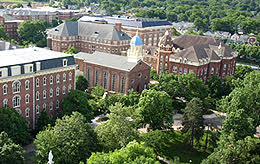September 2015
The University of Dayton in Ohio offers undergraduate education programs (Early Childhood Education, Middle Childhood Education, and Intervention Specialist) and Graduate Reading Endorsement.
Q: Why did you participate in the IDA Review process?
Our decision to participate in the IDA Review process arose in response to the Ohio Board of Regents’ call for all teacher education programs in Ohio to align our programs with the IDA Knowledge and Practice Standards. Aligning our coursework and meeting the expectations of the review process were mutually beneficial processes, so we chose to submit our programs for accreditation by IDA. We understood that IDA accreditation would be prestigious, and the process would be rigorous, thus adding distinction to our program.
Q: How was the experience of preparing for and participating in the review?
Preparing for and participating in the review provided opportunities for discussion and dialogue among our faculty regarding the scope and sequence of our coursework. Collaborative conversations occurred concerning areas in which our curriculum overlapped or needed development, and resulted in overall program improvement. Preparation for the review was an iterative process, in that each decision we made about the integration of the standards into our coursework had ripple effects into other areas of our programs, resulting in revision and updating across the board.
Q: What does IDA Recognition (now Accreditation) mean to your university?
We are pleased to be able to offer programs that meet the Standards of IDA, as our goal is to produce graduates who are well-prepared to meet the variety of needs students will bring to their classrooms. IDA accreditation provided us the opportunity to both revise our current programs and develop new certificate programs for dyslexia studies. Our ability to offer more diverse program options to our students allows them to customize their experience and be more competitive in the job market.
Q: Describe some of the innovative ideas you have implemented to give students a richer practicum experience.
We have developed a partnership with our local Children’s Dyslexia Center to develop a practicum experience that is rich and grounded in the IDA Standards. In addition, we are working with local schools and teachers to develop site-based practicum experiences that also provide a service to the schools. We feel it is important that our students see how the content of the practicum can be implemented within a school-based environment, as our students are primarily classroom teachers or aspiring classroom teachers.
Q: How has your program leveraged outside partnerships to increase students’ learning experience?
The partnership we have developed with the Children’s Dyslexia Center has been invaluable in developing a strong and robust program. By marrying the principles of effective literacy instruction, which our program was already built upon, with the foundations of multisensory instruction for students with dyslexia, our program provides a thorough grounding in effective instruction for a variety of readers and writers. This partnership has helped our students gain insights into the struggles students with dyslexia often face in the classroom, and has given them the tools they need to help their students avoid these same struggles. Our partnerships with local schools remind us of why we chose to develop our program in the first place: to make a difference in the lives of students and teachers. Working with teachers and students to meet the needs of students with dyslexia within the classroom environment is an essential component of our program.
Mary-Kate Sableski, Ph.D, is the director of teacher education at the University of Dayton, Ohio.
Copyright © 2015 International Dyslexia Association (IDA). We encourage sharing of Examiner articles. If portions are cited, please make appropriate reference. Articles may not be reprinted for the purpose of resale. Permission to republish this article is available from info@interdys.org.


